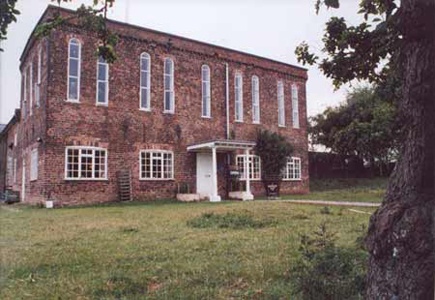Are you thinking about getting a building survey for your home or business? Find out what issues a structural surveyor looks for here. We look at the problems that a house survey can uncover and find out what the building survey can tell you.
Bob Trimble is a chartered architect registered with RIBA with 30 years experience in the industry. Trimble Architects work throughout Hounslow, Twickenham, Richmond, Kingston Upon Thames, Teddington and the surrounding areas of London.
What Problems can a house survey find?
In the majority of cases, building home surveys will come back with no significant issues or problems; however, there is also a chance that it might identify a problem.
Once the problem or issue has been identified, you will then be able to make plans to sort or treat it before it turns into a major problem.
Please see below a list of some of the problems that a complete structural survey might detect when they are carrying out the survey.

Japanese Knotweed
Japanese Knotweed is a fast-growing and highly invasive species that can cause vast amounts of damage to your home.
This plant is not a native species. Japanese Knotweed was first introduced to the United Kingdom as an ornamental plant in gardens and parks as well as highly used to line railway tracks to help stabilise the soil.
In the United Kingdom, Japanese Knotweed is predator-free. It has a resilient, strong root and can grow up to 3 metres in height. Its roots can force their way through cavity walls, concrete, drains, and asphalt to get the light and water it needs to survive.
Providing there is a professional treatment plan and an insurance backed guarantee in place, Japanese Knotweed shouldn't prevent you from being able to get a mortgage on your chosen property.
Woodworm
Woodworm is the most common name for the larvae stage of wood-boring beetles. They are most commonly found in Springtime.
Woodworm will burrow into the timber within your home. They weaken the timber and cause structural damage. If your property has lots of wood, like a barn conversion, they will be more vulnerable.
Although having woodworm is a nuisance, it is rare for you to require structural repairs if you have an infestation. There are cases where an infestation can go undetected, or the source of the infestation was unable to be detected.
In these cases, it would be best practice to contact a professional woodworm company.
Subsidence
Subsidence occurs when the ground beneath the property starts to move downwards because of a change in the soil water content.
The most common cause of subsidence can be vegetation, especially trees that remove the water from the soil. Damaged drains or water pipes can also be a factor in the cause of subsidence and structural movement.
The stability of a property can be affected, and this can make it extremely difficult to insure and can also be dangerous for the people living in the property.
Dry rot
Dry rot is a growing and living fungus that will feed on the timber within a property and weaken it.
Depending on the conditions this fungus thrives in, it can quickly spread. One of the critical ways of treating dry rot is to deal with the underlying cause.
Dry rot needs water to survive, so reducing condensation or mending any leaking pipes can help eliminate it.
Damp Problems
Damp is extremely common, especially in older properties.
If left untreated, dampness can cause structural damage by causing deterioration of plaster and brick. It can rot wood and rust iron and steel structural components.
Living in damp conditions is also unhealthy; it can exacerbate breathing and respiratory problems. Damp will also provide an environment in which bacteria can thrive.
There are three main types of damp:
Condensation: This is the most common type of damp in the United Kingdom. It is caused when water vapour condenses on walls and ceilings. You can usually identify condensation when you see water droplets on your properties walls, plaster might be damaged, and window frames can show signs of decay.
Penetrating Damp: Most common in older properties. It is caused by water leaking through the walls of your home. It usually seeps through cracks in the brickwork of your property. Penetrating damp is often identified by patches of damp on ceilings, walls and floors.
Rising Damp: When water from the underground works its way up through the brickwork of your property, it is a cause of rising damp. The first indications you have a problem with rising damp is peeling wallpaper, damaged or crumbling plaster and damage to your floorboards and skirting boards.
Asbestos
In 1999, Asbestos was banned due to its implications on the health of human beings. However, that was after it had been widely used within the construction industry and used on many buildings.
If a survey finds Asbestos, the seller or yourself will need to have a conversation with an asbestos specialist. It may be possible for the Asbestos to be removed, but if not, preventative measures will need to be taken up.
If it is possible to remove it, then the cost will depend on the type of Asbestos and its use within the property.
Electrical Issues
If issues with the electrics in the property have shown up on the survey, they might only be minor electrical problems or range up to serious issues like a complete property rewire.
If the electrical issues require sorting urgently, then either the seller or yourself will need to contact an electrician.
They will give you details on how the problems can be rectified and perhaps even a quote for the costs of the repairs.
Faulty Drainpipes
If the surveyors' report shows a problem with the properties drainage system, it can indicate that it could cause water pooling or a backlog of water.
These issues have the potential to cause significant water damage to the property, which could cause costly repairs.
Roof Issues
If the surveyors' report detects a problem with the properties roof, it could be that a few roof tiles are missing or broken. It could also detect extensive issues with the internal structure of the roof.
If the issue is only minor, then it most likely won't require a specialist. In most cases, a few roof tiles can be replaced by a handyman who is suitably qualified and doesn't mind working at height.
However, if the roof has a more severe problem, you need to contact a roofing specialist to see how much the costs would be to put it right.
Insulation
The surveyors' report might indicate there is damaged, missing or inefficient insulation; this can result in a cold home, an energy inefficient home could mean you are paying far more for your heating bills.
Not all problems with insulation require the need to employ a company to rectify it; in many cases, you can do it yourself; however, if the damage is inaccessible or has extensive damage, you can always contact a specialist.

What does a building survey tell me?
When you are buying a property, a Building Surveyor carries out a building survey or homebuyer report. The surveyors' report will be detailed and describe the condition of the property and what condition each element of the property is in, and a valuation of the property and what the property is worth.
It will also identify any defects the property might have, what has caused the imperfections, how urgent the repairs are required, what maintenance options you have and in some cases, the approximate costs of each repair.
It's essential to check that the surveyor you choose is regulated by the Royal Institution of Chartered Surveyors (RICS).
RICS set the guidance for chartered surveyors, and they will ensure the advice you get is independent and from a fully trained professional.
Your mortgage lender will also get a copy of the report.
Are you considering commissioning a structural survey of your property? We hope this article has helped you understand more about what a structural surveyor looks for.
If you live in Twickenham or the surrounding areas of London our RIBA registered architect can help. Contact our experts today for structural surveys in London.
Bob Trimble is a chartered architect registered with RIBA. Bob Trimble has 30 years of experience working with residential and commercial property projects. For 4 years, Bob Trimble has worked from his housing association and private architectural practice for clients throughout Hounslow, Twickenham, Richmond, Kingston Upon Thames, Teddington and the surrounding areas of London.


